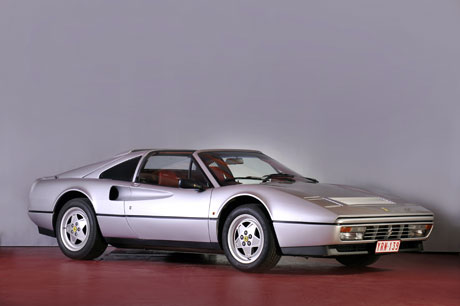SCM Analysis
Detailing
| Vehicle: | 1989 Ferrari 328 GTS |
| Number Produced: | 6,068 |
| Original List Price: | $84,780 in 1989 |
| Distributor Caps: | $400 (takes two) |
| Chassis Number Location: | Top right frame rail in the engine compartment |
| Club Info: | Ferrari Club of America PO Box 720597 Atlanta, GA, 30358 |
| Website: | http://www.ferrariclubofamerica.org |
| Alternatives: | 2003 Aston Martin DB7 Volante, 1988 Lamborghini Jalpa, 1989 Porsche 911 Speedster |
| Investment Grade: | B |
This 1989 Ferrari 328 GTS sold for $82,665, including buyer’s premium, at Bonhams’s Weekend de l’Excellence Automobile Reims Auction in Reims, France, on September 26, 2009.
A popular poster back in the 1980s featured a Coke bottle lying on its side, a shapely girl lying on her side, and the profile of a Ferrari 308 GTB. The implication was that all three were beautiful and all three shared the same profile. The similarity of the profiles may have been a bit of a stretch, but there is no doubt that each image defined beauty.
The 308’s silhouette was not unique among automobile designs. It is a reinterpretation of a classic automobile theme-a long, low hood with a roofline that flows far into the rear of the car. The 308’s silhouette was not even unique among Ferrari designs, as the long, low hood and flowing roofline were almost a Ferrari trademark. Somehow, however, the 308’s designers were able to mix new angles and curves with the borrowed silhouette to create a shape that was truly unique. There is no other like it on the road, and there is no doubt the elegant shape still fuels the popularity of the car today.
328 was a leap into the present in 1985
The 308 series was nearly twelve years old when the 328 was introduced. There had been steady improvements to the model with new engines and tweaks to the styling, but the overall package stayed pretty much the same, and by 1985 it was losing ground to the competition. The Ferrari 328 GTS Targa was simply a leap to the present, adding respectability to the performance while ignoring the creature comforts found in the most basic family sedans. The 328 Targa followed the 308’s styling cues but updated them with bumper covers that make the bumpers part of the body design. This relatively simple update made a major change in the car’s visual character. The delicate lines of the 308 became masculine in the 328, complementing the car’s performance enhancements and differentiating it from its predecessor. It’s debatable whether the 308 or the 328 is the more attractive, but there’s no doubt the 328 is the better car.
Along with new bumpers and wheels, the 328 got a new, more comfortable and higher quality interior. The 328’s magic wasn’t in its appearance, though; it was under the hood. Following Ferrari’s tradition of naming a car after its engine, the 3-liter 308 was bumped 200 cc to become a 328. The added displacement made a bit more horsepower, but it was the added torque that transformed the car. Americans used to large-displacement Detroit V8s often shifted before a 308 reached its power band. They complained that the 308’s performance was disappointing. The 328 had more torque at lower rpm and woke up the car for these buyers.
Over the years the 328 GTS Targa has proven to be an excellent car. The mechanicals are nearly bulletproof with regular service. And there’s hardly anything mechanical that can’t be done by a good neighborhood garage. Service parts are readily available, but trim parts are drying up. The front foglight/turn signal assemblies are impossible to find, while the electronic temperature/vent controls are merely difficult to find-and they are $750 each when you do. Expect to pay $3,000-$4,000 for a major service, but often that can be trimmed to a much less expensive timing belt change, if the car’s not driven much.
Matching the leather is near impossible
Cosmetic issues are a different story. The factory paint was high-quality modern enamel, and with reasonable care the original paint should still look good. A quality repaint will start at $7,000 and will take longer than you could ever dream. The 328’s interior is a weak point. The soft, top-grain leather Ferrari uses is wonderful when it’s new, but it doesn’t hold up. Matching the factory leather is nearly impossible, so short of a complete retrim for $7,000, you may not be able to make a worn interior look much better.
While the European price of most modern exotics generally trails the U.S. pricing, the 328 seems to be an exception. SCM’s auction results shows Bonhams is the high price leader with the $124k sale of a 1989 328 GTS at its 2007 Gstaad auction. Just last spring, RM sold a 1989 328 GTS for over $90k at its Maranello auction. In contrast, the highest U.S. sale was $77k and the second place wasn’t even close. Granted, these were extraordinarily low-mileage examples, but the point is that a top-quality, late-model 328 can bring big money.
There are only a handful of 1980s vintage cars that sell for anywhere close to their original list price. The Bonhams 328 GTS Targa, s/n 81327, sold at $82k, makes the list. Obviously inflation and holding costs made it a poor investment, but in a modern car, this degree of value retention is rarified air. The seller of s/n 81327 got a little less than top dollar, but considering silver isn’t the best color for the car, he did just fine. The buyer, in turn, got a great car for a fair price. As long as he keeps it in the garage, he can plan on getting his money back. If he decides to drive it around, he’ll find those miles to be quite expensive.
